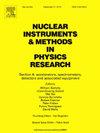Data analysis procedures to improve energy resolution in silicon detectors using GET electronics
IF 1.5
3区 物理与天体物理
Q3 INSTRUMENTS & INSTRUMENTATION
Nuclear Instruments & Methods in Physics Research Section A-accelerators Spectrometers Detectors and Associated Equipment
Pub Date : 2024-11-05
DOI:10.1016/j.nima.2024.170016
引用次数: 0
Abstract
This study primarily focuses on improving the energy resolution of Double-Sided Silicon Strip Detectors (DSSSD) through optimized data analysis procedures using General Electronics for Time Projection Chambers (GET). We introduce two edge identification algorithms that demonstrate comparable efficacy. These methods are subsequently integrated with various techniques for measuring pulse amplitude, including sample smoothing and pole-zero cancellation. Notably, sample smoothing significantly enhances performances, achieving a resolution of 0.33 % with DSSSD calibration data. Additionally, we describe and apply the trapezoidal filter, examining its impact on resolution improvement and obtaining comparable results. The study also evaluates how internal GET parameters, specifically the sampling frequency and the shaping time of the Sallen-Key (SK) low-pass filter, affect signal resolution. Higher sampling frequencies and lower values of the SK filter were found to increase performance.
利用 GET 电子技术提高硅探测器能量分辨率的数据分析程序
本研究主要侧重于通过使用时间投影室(GET)通用电子技术优化数据分析程序,提高双面硅带探测器(DSSSD)的能量分辨率。我们介绍了两种边缘识别算法,它们的功效相当。这些方法随后与测量脉冲幅度的各种技术相结合,包括采样平滑和极零消除。值得注意的是,采样平滑显著提高了性能,通过 DSSSD α 校准数据实现了 0.33 % 的分辨率。此外,我们还介绍并应用了梯形滤波器,检查了其对提高分辨率的影响,并获得了类似的结果。研究还评估了 GET 内部参数,特别是 Sallen-Key (SK) 低通滤波器的采样频率和整形时间对信号分辨率的影响。研究发现,较高的采样频率和较低的 SK 滤波器值可提高性能。
本文章由计算机程序翻译,如有差异,请以英文原文为准。
求助全文
约1分钟内获得全文
求助全文
来源期刊
CiteScore
3.20
自引率
21.40%
发文量
787
审稿时长
1 months
期刊介绍:
Section A of Nuclear Instruments and Methods in Physics Research publishes papers on design, manufacturing and performance of scientific instruments with an emphasis on large scale facilities. This includes the development of particle accelerators, ion sources, beam transport systems and target arrangements as well as the use of secondary phenomena such as synchrotron radiation and free electron lasers. It also includes all types of instrumentation for the detection and spectrometry of radiations from high energy processes and nuclear decays, as well as instrumentation for experiments at nuclear reactors. Specialized electronics for nuclear and other types of spectrometry as well as computerization of measurements and control systems in this area also find their place in the A section.
Theoretical as well as experimental papers are accepted.

 求助内容:
求助内容: 应助结果提醒方式:
应助结果提醒方式:


